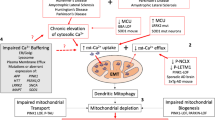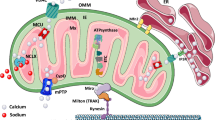Abstract
Overactivation of glutamate receptors results in neurodegeneration in a variety of brain pathologies, including ischemia, epilepsy, traumatic brain injury and slow-progressing neurodegenerative disorders. In all these pathologies, it is well accepted that the calcium-dependent cysteine proteases calpains are key players in the mechanisms of neuronal cell death. Many research groups have been actively pursuing to establish a link between the deregulation of intracellular Ca2+ homeostasis associated with excitotoxicity and calpain activity. It is well established that these two events are connected and interact synergistically to promote neurodegeneration, but whether calpain activity depends on or contributes to Ca2+ deregulation is still under debate.
Similar content being viewed by others
References
Budd SL, Nicholls DG (1996) Mitochondria, calcium regulation, and acute glutamate excitotoxicity in cultured cerebellar granule cells. J Neurochem 67(6):2282–2291
Khodorov B (2004) Glutamate-induced deregulation of calcium homeostasis and mitochondrial dysfunction in mammalian central neurones. Prog Biophys Mol Biol 86(2):279–351
Arundine M, Tymianski M (2003) Molecular mechanisms of calcium-dependent neurodegeneration in excitotoxicity. Cell Calcium 34(4–5):325–337
Nicholls DG, Budd SL, Ward MW et al (1999) Excitotoxicity and mitochondria. Biochem Soc Symp 66:55–67
Bevers MB, Neumar RW (2008) Mechanistic role of calpains in postischemic neurodegeneration. J Cereb Blood Flow Metab 28(4):655–673
Liu J, Liu MC, and Wang KK (2008) Calpain in the CNS: from synaptic function to neurotoxicity. Sci Signal 1(14): re1
Araujo IM, Carvalho CM (2005) Role of nitric oxide and calpain activation in neuronal death and survival. Curr Drug Targets CNS Neurol Disord 4(4):319–324
Frandsen A, Schousboe A (1993) Excitatory amino acid-mediated cytotoxicity and calcium homeostasis in cultured neurons. J Neurochem 60(4):1202–1211
Nicholls DG (1986) Intracellular calcium homeostasis. Br Med Bull 42(4):353–358
Tymianski M, Charlton MP, Carlen PL et al (1993) Source specificity of early calcium neurotoxicity in cultured embryonic spinal neurons. J Neurosci 13(5):2085–2104
Sattler R, Tymianski M, Feyaz I et al (1996) Voltage-sensitive calcium channels mediate calcium entry into cultured mammalian sympathetic neurons following neurite transection. Brain Res 719(1–2):239–246
Araujo IM, Carreira BP, Pereira T et al (2007) Changes in calcium dynamics following the reversal of the sodium-calcium exchanger have a key role in AMPA receptor-mediated neurodegeneration via calpain activation in hippocampal neurons. Cell Death Differ 14(9):1635–1646
Nicholls DG, Budd SL (1998) Mitochondria and neuronal glutamate excitotoxicity. Biochim Biophys Acta 1366(1–2):97–112
Nicholls DG, Budd SL (1998) Neuronal excitotoxicity: the role of mitochondria. Biofactors 8(3–4):287–299
Abramov AY, Duchen MR (2010) Impaired mitochondrial bioenergetics determines glutamate-induced delayed calcium deregulation in neurons. Biochim Biophys Acta 1800(3):297–304
Abramov AY, Duchen MR (2008) Mechanisms underlying the loss of mitochondrial membrane potential in glutamate excitotoxicity. Biochim Biophys Acta 1777(7–8):953–964
Vergun O, Keelan J, Khodorov BI et al. (1999) Glutamate-induced mitochondrial depolarization and perturbation of calcium homeostasis in cultured rat hippocampal neurones. J Physiol 519 Pt 2: 451–466
Dietz RM, Kiedrowski L, Shuttleworth CW (2007) Contribution of Na(+)/Ca(2+) exchange to excessive Ca(2+) loading in dendrites and somata of CA1 neurons in acute slice. Hippocampus 17(11):1049–1059
Kiedrowski L, Brooker G, Costa E et al (1994) Glutamate impairs neuronal calcium extrusion while reducing sodium gradient. Neuron 12(2):295–300
Kiedrowski L (2007) Critical role of sodium in cytosolic [Ca2+] elevations in cultured hippocampal CA1 neurons during anoxic depolarization. J Neurochem 100(4):915–923
Storozhevykh TP, Senilova YE, Brustovetsky T et al (2010) Neuroprotective effect of KB-R7943 against glutamate excitotoxicity is related to mild mitochondrial depolarization. Neurochem Res 35(2):323–335
Bano D, Young KW, Guerin CJ et al (2005) Cleavage of the plasma membrane Na+/Ca2+ exchanger in excitotoxicity. Cell 120(2):275–285
Gerencser AA, Mark KA, Hubbard AE et al (2009) Real-time visualization of cytoplasmic calpain activation and calcium deregulation in acute glutamate excitotoxicity. J Neurochem 110(3):990–1004
Brustovetsky T, Bolshakov A, Brustovetsky N (2010) Calpain activation and Na+/Ca2+ exchanger degradation occur downstream of calcium deregulation in hippocampal neurons exposed to excitotoxic glutamate. J Neurosci Res 88(6):1317–1328
Molinaro P, Cuomo O, Pignataro G et al (2008) Targeted disruption of Na+/Ca2+ exchanger 3 (NCX3) gene leads to a worsening of ischemic brain damage. J Neurosci 28(5):1179–1184
Zhao X, Gorin FA, Berman RF et al (2008) Differential hippocampal protection when blocking intracellular sodium and calcium entry during traumatic brain injury in rats. J Neurotrauma 25(10):1195–1205
Schroder UH, Breder J, Sabelhaus CF et al (1999) The novel Na+/Ca2+ exchange inhibitor KB-R7943 protects CA1 neurons in rat hippocampal slices against hypoxic/hypoglycemic injury. Neuropharmacology 38(2):319–321
Pilitsis JG, Diaz FG, O’Regan MH et al (2001) Inhibition of Na(+)/Ca(2+) exchange by KB-R7943, a novel selective antagonist, attenuates phosphoethanolamine and free fatty acid efflux in rat cerebral cortex during ischemia-reperfusion injury. Brain Res 916(1–2):192–198
Matsuda T, Arakawa N, Takuma K et al (2001) SEA0400, a novel and selective inhibitor of the Na+-Ca2+ exchanger, attenuates reperfusion injury in the in vitro and in vivo cerebral ischemic models. J Pharmacol Exp Ther 298(1):249–256
Rami A, Krieglstein J (1993) Protective effects of calpain inhibitors against neuronal damage caused by cytotoxic hypoxia in vitro and ischemia in vivo. Brain Res 609(1–2):67–70
Bevers MB, Ingleton LP, Che D et al (2010) RNAi targeting micro-calpain increases neuron survival and preserves hippocampal function after global brain ischemia. Exp Neurol 224(1):170–177
Li PA, Howlett W, He QP et al (1998) Postischemic treatment with calpain inhibitor MDL 28170 ameliorates brain damage in a gerbil model of global ischemia. Neurosci Lett 247(1):17–20
Markgraf CG, Velayo NL, Johnson MP et al (1998) Six-hour window of opportunity for calpain inhibition in focal cerebral ischemia in rats. Stroke 29(1):152–158
Kawamura M, Nakajima W, Ishida A et al (2005) Calpain inhibitor MDL 28170 protects hypoxic-ischemic brain injury in neonatal rats by inhibition of both apoptosis and necrosis. Brain Res 1037(1–2):59–69
Kupina NC, Nath R, Bernath EE et al (2001) The novel calpain inhibitor SJA6017 improves functional outcome after delayed administration in a mouse model of diffuse brain injury. J Neurotrauma 18(11):1229–1240
Czeiter E, Buki A, Bukovics P et al (2009) Calpain inhibition reduces axolemmal leakage in traumatic axonal injury. Molecules 14(12):5115–5123
Saatman KE, Zhang C, Bartus RT et al (2000) Behavioral efficacy of posttraumatic calpain inhibition is not accompanied by reduced spectrin proteolysis, cortical lesion, or apoptosis. J Cereb Blood Flow Metab 20(1):66–73
Saatman KE, Murai H, Bartus RT et al (1996) Calpain inhibitor AK295 attenuates motor and cognitive deficits following experimental brain injury in the rat. Proc Natl Acad Sci USA 93(8):3428–3433
Araujo IM, Gil JM, Carreira BP et al (2008) Calpain activation is involved in early caspase-independent neurodegeneration in the hippocampus following status epilepticus. J Neurochem 105(3):666–676
Wang S, Shan P, Song Z et al (2008) Mu-calpain mediates hippocampal neuron death in rats after lithium-pilocarpine-induced status epilepticus. Brain Res Bull 76(1–2):90–96
Higuchi M, Tomioka M, Takano J et al (2005) Distinct mechanistic roles of calpain and caspase activation in neurodegeneration as revealed in mice overexpressing their specific inhibitors. J Biol Chem 280(15):15229–15237
Acknowledgments
This work was funded by Foundation for Science and Technology (FCT), Portugal, Grants PTDC/SAU-NEU/102612/2008 and PTDC/SAU-NMC/112183/2009. Bruno P. Carreira is funded by a fellowship provided by FCT (SFRH/BD/23754/2005).
We acknowledge the great contribution of Abel Lajtha in setting up the early stages of our institution and in training some of our scientific personnel in his laboratory. Abel has been an inspiration to our younger researchers, and created many opportunities for them.
Author information
Authors and Affiliations
Corresponding author
Additional information
Special Issue: In Honor of Dr. Abel Lajtha.
Rights and permissions
About this article
Cite this article
Araújo, I.M., Carreira, B.P., Carvalho, C.M. et al. Calpains and Delayed Calcium Deregulation in Excitotoxicity. Neurochem Res 35, 1966–1969 (2010). https://doi.org/10.1007/s11064-010-0323-z
Accepted:
Published:
Issue Date:
DOI: https://doi.org/10.1007/s11064-010-0323-z




